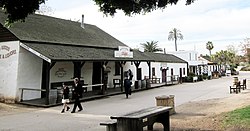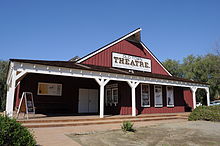
El Presidio Real de Santa Bárbara, also known as the Royal Presidio of Santa Barbara, is a former military installation in Santa Barbara, California, United States. The presidio was built by Spain in 1782, with the mission of defending the Second Military District in California. In modern times, the Presidio serves as a significant tourist attraction, museum and an active archaeological site as part of El Presidio de Santa Barbara State Historic Park.

Monterey State Historic Park is a historic state park in Monterey, California. It includes part or all of the Monterey Old Town Historic District, a historic district that includes 17 contributing buildings and was declared a National Historic Landmark in 1970. The grounds include California's first theatre, and the Monterey Custom House, where the American flag was first raised over California.

El Presidio Real de San Diego is a historic fort in San Diego, California. It was established on May 14, 1769, by Gaspar de Portolá, leader of the first European land exploration of Alta California—at that time an unexplored northwestern frontier area of New Spain. The presidio was the first permanent European settlement on the Pacific Coast of the present-day United States. As the first of the presidios and Spanish missions in California, it was the base of operations for the Spanish colonization of California. The associated Mission San Diego de Alcalá later moved a few miles away.

José Antonio Estudillo was a Californio ranchero, politician, and soldier, who served as Alcalde of San Diego and as San Diego County Assessor. He was a member of the Estudillo family of California, a prominent Californio family of San Diego.
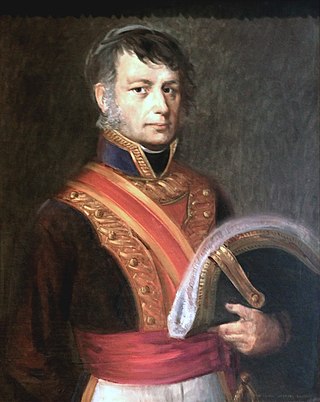
José María Estudillo was a Spanish-born Californio military officer and early settler of San Diego. He is the founder of the Estudillo family of California and served as Commandant of the Presidio of San Diego.
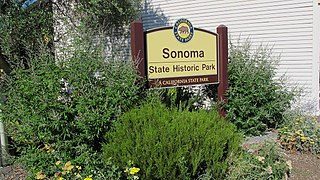
Sonoma State Historic Park is a California State Park located in the center of Sonoma, California. The park consists of six sites: the Mission San Francisco Solano, the Sonoma Barracks, the Blue Wing Inn, La Casa Grande, Lachryma Montis, and the Toscano Hotel.

The José Castro House, sometimes known as the Castro-Breen Adobe, is a historic adobe home in San Juan Bautista, California, facing the Plaza de San Juan. The Monterey Colonial style house was built 1838-41 by General José Antonio Castro, a former Governor of Alta California. It was later sold to the Breen family, who lived there until 1933, when the house became a museum as part of San Juan Bautista State Historic Park.

The Casa de Estudillo, also known as the Estudillo House, is a historic adobe house in San Diego, California, United States. It was constructed in 1827 by José María Estudillo and his son José Antonio Estudillo, early settlers of San Diego and members of the prominent Estudillo family of California, and was considered one of the finest houses in Mexican California. It is located in Old Town San Diego State Historic Park, and is designated as both a National and a California Historical Landmark in its own right.

Rancho Guajome Adobe is a historic 19th-century hacienda in Rancho Guajome Adobe County Park, on North Santa Fe Avenue in Vista, San Diego County, California. Built in 1852–53, it is a well-preserved but late example of Spanish-Mexican colonial architecture, and was designated a National Historic Landmark in 1970. It is also a California Historical Landmark and on the National Register of Historic Places.

Old Town is a neighborhood of San Diego, California. It contains 230 acres (93 ha) and is bounded by Interstate 8 on the north, Interstate 5 on the west, Mission Hills on the east and south. It is the oldest settled area in San Diego and is the site of the first European settlement in present-day California. It contains Old Town San Diego State Historic Park and Presidio Park, both of which are listed on the National Register of Historic Places.

The Estudillo family is a prominent Californio family of Southern California. Members of the family held extensive ranchos and numerous important positions, including California State Treasurer, Mayor of San Diego, and Commandant of the Presidio of San Diego.

The Cosmopolitan Hotel and Restaurant in the Old Town San Diego State Historic Park is a registered national historic landmark, built in the early 19th century by Juan Bandini and later purchased by Albert Seeley to serve as a stagecoach hotel. In 2010, restorations and added fine dining restaurant revived the hotel to its 1870s charm, making it again a focal point of the original downtown area.

The Covarrubias adobe is a California Historical Landmark in Santa Barbara, California. The house is one of the oldest in Santa Barbara, built in 1817. The adobe became a California State Historical Landmark No. 308 on September 12, 1939. The house is also on the Santa Barbara City Landmark. The house is located at 715 Santa Barbara Street. The house is a L-shaped with four rooms, the original Spanish tile roof was later replaced.

Casa de Carrillo House in San Diego, California in San Diego County, is a California Historical Landmark No. 74 listed on December 6, 1932. The Casa de Carrillo House is the oldest residence in San Diego. The Casa de Carrillo House was built by Presidio of San Diego Comandante Francisco María Ruiz (1754–1839). Ruiz was the leader of the Presidio from 1809 to 1827. The Casa de Carrillo house was built next to his pear orchard planted in 1808. The Adobe house was used by his relative and soldier, Joaquín Carrillo, and his family. Joaquín Carrillo, daughter Josefa Carrillo, ran away and sailed from the home and eloped to Chile with Henry Delano Fitch in April 1829. Francisco Ruiz died in 1839, when Joaquín Carrillo died, his son Ramon Carrillo sold the house and land to Lorenzo Soto. The house and land was sold a few times, it was poor condiction when sold in 1932 to George Marston and associates. George Marston and associates restored the house. After the restoration George Marston and associates donated the house and land to the City of San Diego. The City of San Diego turned the house and land into the Presidio Hills Golf Course.
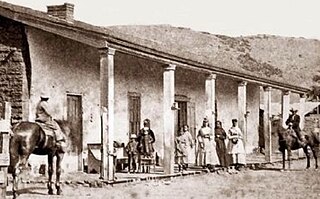
Casa de Lopez was a historical Adobe building in San Diego, California built in 1835. The Casa de Lopez site is a California Historical Landmark No. 60, listed on December 6, 1932. Casa de Lopez, often called the long House, built by Juan Francisco Lopez, a Spanish settler of San Diego. Casa de Lopez was one of the first large houses built in San Diego. Juan Matias Moreno lived in the house starting in 1846. Juan Matias Moreno as the secretary to 10th Governor of Alta California, Governor Pío Pico, the last Mexican governor. The house, with a current address of 3890 Twiggs Street, is now a restaurant in Old Town, San Diego. A Historical marker is on corner of Twiggs Street west of Congress Street built by the California State Park Commission.

Casa de Machado, also called Casa de Machado y Silvas is a historical Adobe building in San Diego, California built in 1832. The Casa de Lopez site is a California Historical Landmark No. 71, listed on December 6, 1932. Casa de Machado was built by José Manuel Machado, pioneer leatherjacket company soldier of the New Spain Army stationed in San Diego. He arrived at the San Diego Presidio in 1782 when he retired. José Manuel Machado built a house, Casa de Stewart, for his daughter Rosa, she married Jack Stewart. Stewart from Maine and was pilot boat operator in Maine. The Stewarts enlarged the house. Carmen Stewart Meza lived in the house for some years. The 1850s it was a Commercial Restaurant. 1930s, The Machado y Silvas family owned the house until the 1930s. In the 1930s and early 1940s the house was rooming-house, café, art studio, and souvenir shop. In 1942 the house became a church, Machado Memorail Chapel. Casa de Machado was acquired by California State Parks in 1968, who had it restored. The Casa de Machado y Silvas house's current address, 2737 San Diego Avenue, in Old Town, San Diego.
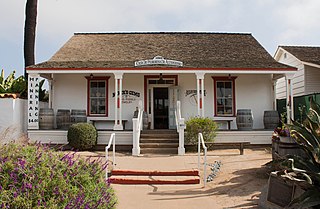
Casa de Pedrorena, also called Altamirano-Pedrorena House is a historical Adobe building in San Diego, California built in 1869. The Casa de Lopez site is a California Historical Landmark No. 70, listed on December 6, 1932. Casa de Pedrorena was the home of Miguel de Pedrorena. In 1838 Miguel de Pedrorena arrived in San Diego Viejo. Don Miguel was a member of the California Constitutional Conventions at Monterey, California in 1849. Monterey Convention of 1849 was the first California Constitutional Convention to take place, a major decidion of the convention was to ban slavery and set state boundaries. Pedrorena sister, Isabel de Altamirano, received the house in January 1871. Isabel de Altamirano married Jose Antonio Altamirano and they raised their family here. Jose Antonio Altamirano was born in 1835 in La Paz, Baja California. Jose Altamirano arrived in San Diego in 1849. In San Diego he did some mining and raised cattle in San Diego and Baja California. The house's current address, 2616 San Diego Ave in Old Town, San Diego. Casa de Pedrorena is the newest and last of Old Town San Diego's adobe houses.

Casa de Stewart, also called La Casa de Machado y Stewart is a historical adobe building in San Diego, California built in 1835. The Casa de Stewart site is a California Historical Landmark No. 73, listed on December 6, 1932.

San Diego Viejo Plaza, also called Plaza de Las Armas, Old Town Plaza, Washington Square, is a historical site in San Diego, California. The San Diego Viejo Plaza site is California Historical Landmark No. 63, listed on December 5, 1932. The plaza was the center of Pueblo de San Diego founded in 1835 in Alta California.
